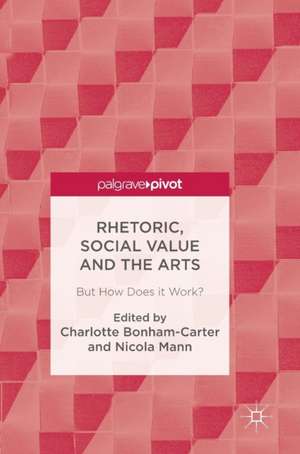Rhetoric, Social Value and the Arts: But How Does it Work?
Editat de Charlotte Bonham-Carter, Nicola Mannen Limba Engleză Hardback – 28 iul 2017
The book reveals how the ‘social value of art’ may have one meaning for a policy maker, another for a museum and still yet another for an artist – and it is therefore in the interaction between these agents that we learn the most about the importance of rhetoric and interpretation. As a trajectory in art history, socially engaged art has a long and established history. However, in recent years—or since ‘the social turn’ that occurred in the 1990s—the rhetoric surrounding the social value of art has been assimilated by cultural policy makers and museums. Interdisciplinary in its approach, and bringing together contributions from artists, curators and academics, the volume explores rhetoric, social value and the arts within different social, political and cultural contexts.
| Toate formatele și edițiile | Preț | Express |
|---|---|---|
| Paperback (1) | 413.27 lei 43-57 zile | |
| Springer International Publishing – 12 mai 2018 | 413.27 lei 43-57 zile | |
| Hardback (1) | 422.70 lei 43-57 zile | |
| Springer International Publishing – 28 iul 2017 | 422.70 lei 43-57 zile |
Preț: 422.70 lei
Nou
Puncte Express: 634
Preț estimativ în valută:
80.91€ • 87.91$ • 68.01£
80.91€ • 87.91$ • 68.01£
Carte tipărită la comandă
Livrare economică 21 aprilie-05 mai
Preluare comenzi: 021 569.72.76
Specificații
ISBN-13: 9783319452968
ISBN-10: 3319452967
Pagini: 172
Ilustrații: IX, 172 p. 7 illus. in color.
Dimensiuni: 148 x 210 mm
Greutate: 0.45 kg
Ediția:1st ed. 2017
Editura: Springer International Publishing
Colecția Palgrave Macmillan
Locul publicării:Cham, Switzerland
ISBN-10: 3319452967
Pagini: 172
Ilustrații: IX, 172 p. 7 illus. in color.
Dimensiuni: 148 x 210 mm
Greutate: 0.45 kg
Ediția:1st ed. 2017
Editura: Springer International Publishing
Colecția Palgrave Macmillan
Locul publicării:Cham, Switzerland
Cuprins
Introduction. Rhetoric, Social Value and the Arts: But How Does it Work? - By Nicola Mann.- PART 1.- 1. Who sets the agenda? Changing attitudes towards the relevance of small-scale visual arts organisations in the UK - By Rachel Mader.- 2. From Social Inclusion to Audience Numbers: Art Museums in the New Public Management - By Charlotte Bonham-Carter.- PART 2.- 3. Re-Thinking the Social Turn: The Social Function
of Art as Functionless and Anti-Social - By Ana Yarto Bilbao.- 4. The Paradoxical Engagement of Contemporary Art with Anti-Capitalism, Activism, and Protest - By Tijen Tunali.- PART 3.- 5. Arte de Conducta: On Tania Bruguera’s Tatlin’s Whisper Series - By Andrés David Montenegro Rosero.- 6. PERCENT FOR GREEN: Creating Space as Consciousness - By Alicia Grullón.- PART 4.- 7. Artists on the Gallery Payroll: A Case Study and a Corporate Turn - By Lawrence Bradby and Judith Stewart.- 8. Collecting Social Things - By Joey Orr.- Conclusion - By Charlotte Bonham-Carter.-
Notă biografică
Charlotte Bonham-Carter is Course Leader of MA Arts and Cultural Enterprise at Central Saint Martins, University of the Arts London, UK. She has held curatorial positions at Barbican Art Gallery, London; Institute for Contemporary Arts, London and Art on the Underground, the contemporary art programme of the Tube. She maintains a professional practice as a researcher and arts management consultant.
Nicola Mann is Assistant Professor of Communications and Visual Cultures at Richmond, The American International University in London, UK. She holds an MA in Painting from the Royal College of Art, London, UK and received a PhD in Visual and Cultural Studies from the University of Rochester, New York, USA.
Textul de pe ultima copertă
The book reveals how the ‘social value of art’ may have one meaning for a policy maker, another for a museum and still yet another for an artist – and it is therefore in the interaction between these agents that we learn the most about the importance of rhetoric and interpretation. As a trajectory in art history, socially engaged art has a long and established history. However, in recent years—or since ‘the social turn’ that occurred in the 1990s—the rhetoric surrounding the social value of art has been assimilated by cultural policy makers and museums. Interdisciplinary in its approach, and bringing together contributions from artists, curators and academics, the volume explores rhetoric, social value and the arts within different social, political and cultural contexts.
Caracteristici
Presents a variety of perspectives on social practice Considers the social, political, curatorial and institutional contexts and implications Includes a range of artists discussing their own projects as case studies



























